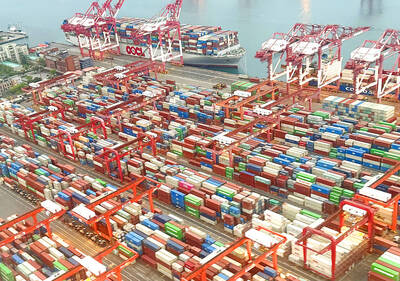As a land that suffers frequent earthquakes, how to effectively alert people to the natural disaster has been the subject of much research in Taiwan.
Now, a National Taiwan University (NTU) academic has made a breakthrough that could help save lives.
NTU Department of Geosciences professor Wu Yih-min (吳逸民) yesterday unveiled an earthquake sensor that could help the Central Weather Bureau issue an earthquake alert 10 to 30 seconds before destructive shock waves hit a location.
Showing reporters a tiny sensor in an iron box, Wu said the technique was based on the difference in the speed at which horizontal and vertical waves travel.
“If an earthquake takes place in Hualien, it would take the P-waves [vertical] 15 seconds to travel [to Taipei] ... but it would take the S- waves [horizontal] 30 seconds to arrive here. So we would still have about 10 seconds to issue a warning,” Wu said.
P-waves are less destructive and travel faster than S-waves.
Wu’s device, which costs about NT$1,000, monitors earthquakes on land and offshore and calculates their intensity and scale.
Similar, but slower, devices had been adopted in the US, Japan, Italy and South Korea, Wu said.
Wu’s research has been published in journals such as the Geophysical Research Letters.
Central Weather Bureau Seismology Center Director Kuo Kai-wen (郭鎧紋) said the bureau worked with Wu and other scientists at NTU and the National Center for Research on Earthquake Engineering for many years, although he said he had yet to read Wu’s article.
Commenting on Wu’s system, Kuo said: “The point is to send out accurate messages in the quickest time possible.”
“We can quickly send out messages to schools or nuclear power plants, but they must also be able to interpret the information and take appropriate measures,” Kuo said.
Kuo said the bureau has been involved in an 18-year plan to gradually reduce the time needed to disseminate earthquake information since 1991.
By 1998, the bureau had succeeded in reducing the time it took to alert people to earthquakes from within 30 minutes to 30 seconds after an earthquake begins.
Starting next year, the bureau will aim to cut the time it takes to report an earthquake from 30 seconds to 20 seconds. To avoid ground interference, the bureau is planning to drill 40 wells at a depth of 200m around the country to install underground earthquake detectors. In the meantime, it is installing undersea cables along the East Coast to monitor undersea earthquakes as well.
The bureau has also installed earthquake detectors at 40 of the Taiwan Railway Administration’s power substations.
The detectors will automatically shut down the railway’s power system if they report an earthquake that exceeds 5 on the Richter Scale. Trains used in the high-speed rail system were equipped with a similar system when they were purchased.

MORE VISITORS: The Tourism Administration said that it is seeing positive prospects in its efforts to expand the tourism market in North America and Europe Taiwan has been ranked as the cheapest place in the world to travel to this year, based on a list recommended by NerdWallet. The San Francisco-based personal finance company said that Taiwan topped the list of 16 nations it chose for budget travelers because US tourists do not need visas and travelers can easily have a good meal for less than US$10. A bus ride in Taipei costs just under US$0.50, while subway rides start at US$0.60, the firm said, adding that public transportation in Taiwan is easy to navigate. The firm also called Taiwan a “food lover’s paradise,” citing inexpensive breakfast stalls

TRADE: A mandatory declaration of origin for manufactured goods bound for the US is to take effect on May 7 to block China from exploiting Taiwan’s trade channels All products manufactured in Taiwan and exported to the US must include a signed declaration of origin starting on May 7, the Bureau of Foreign Trade announced yesterday. US President Donald Trump on April 2 imposed a 32 percent tariff on imports from Taiwan, but one week later announced a 90-day pause on its implementation. However, a universal 10 percent tariff was immediately applied to most imports from around the world. On April 12, the Trump administration further exempted computers, smartphones and semiconductors from the new tariffs. In response, President William Lai’s (賴清德) administration has introduced a series of countermeasures to support affected

CROSS-STRAIT: The vast majority of Taiwanese support maintaining the ‘status quo,’ while concern is rising about Beijing’s influence operations More than eight out of 10 Taiwanese reject Beijing’s “one country, two systems” framework for cross-strait relations, according to a survey released by the Mainland Affairs Council (MAC) on Thursday. The MAC’s latest quarterly survey found that 84.4 percent of respondents opposed Beijing’s “one country, two systems” formula for handling cross-strait relations — a figure consistent with past polling. Over the past three years, opposition to the framework has remained high, ranging from a low of 83.6 percent in April 2023 to a peak of 89.6 percent in April last year. In the most recent poll, 82.5 percent also rejected China’s

PLUGGING HOLES: The amendments would bring the legislation in line with systems found in other countries such as Japan and the US, Legislator Chen Kuan-ting said Democratic Progressive Party (DPP) Legislator Chen Kuan-ting (陳冠廷) has proposed amending national security legislation amid a spate of espionage cases. Potential gaps in security vetting procedures for personnel with access to sensitive information prompted him to propose the amendments, which would introduce changes to Article 14 of the Classified National Security Information Protection Act (國家機密保護法), Chen said yesterday. The proposal, which aims to enhance interagency vetting procedures and reduce the risk of classified information leaks, would establish a comprehensive security clearance system in Taiwan, he said. The amendment would require character and loyalty checks for civil servants and intelligence personnel prior to